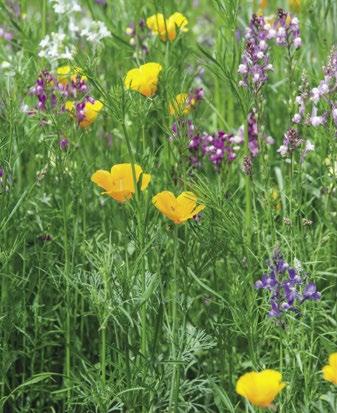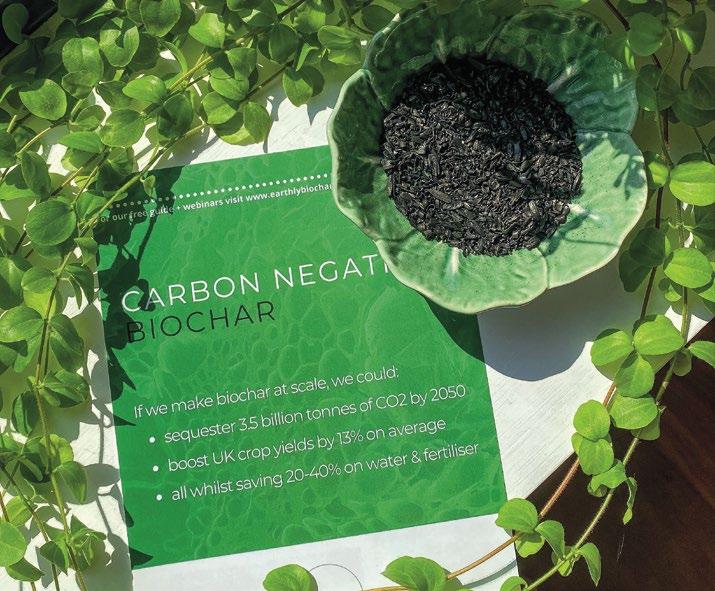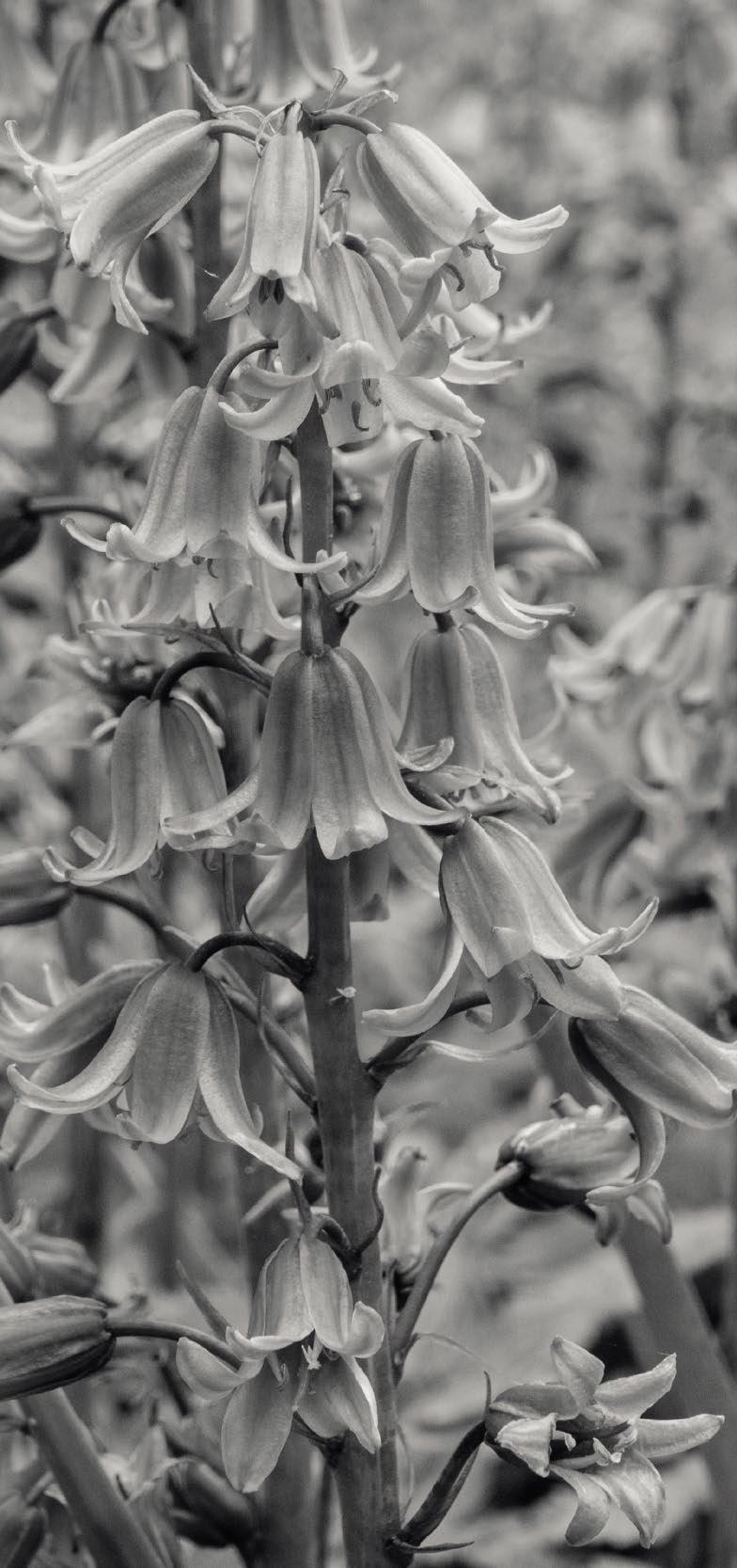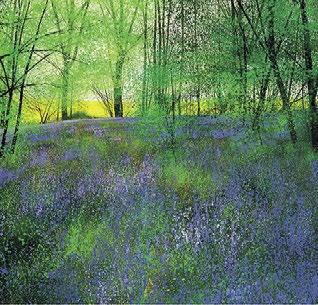
17 minute read
HOME & GARDEN
DIGGING DEEP
Gardening with Pulse
We’ve spent the past couple of issues advising how and when to start planning the year ahead for your garden and when to think about putting down the seeds that will provide good stuff throughout the year – including fruit and vegetables.
But this month, we are turning our attention to something else you can do to enhance your outside space, and it’s an easy way to help bees and butterflies find their way to you; by sowing wildflowers.
Wildflowers will transform a bland space into an attractive one that is bursting with colour and life.
As a youngster, I used to love feeling the sun on my back, taking in the views of the blooming wildflowers, and listening to the chirping of grasshoppers, but it’s something that future generations will never experience unless we act now.
In less than a century, 97% of our wild flower meadows have been lost.
Of course, our own back gardens don’t lend themselves to a luscious green meadow bursting with pops of wildflower colour, but we can still help to make a difference. If we all do a little, the combined efforts count for a lot.
We can start by ditching the fake stuff!
Insects can’t live in fake grass, birds can’t feed from it, and it uses plastic which can’t be recycled. At a time when our wildlife is struggling to adapt to loss of habitat because of our intensive farming and new builds, do we really need to add plastic grass into the mix of issues for them? Micro plastics will also find their way into our soil, and the contamination will last for centuries.
And, while you might think they look attractive, it won’t take too many years before the fake lawns look nasty. We’re not trying to vilify those of you who are looking outside at your own plastic installation, but if you do have a fake lawn, you will also know that while they remove the need for a mower, they still need to be washed and brushed...even hoovered!
It’s best to turf out the pretend turf and get back to nature. The birds and the butterflies will love you for it, and there’s a reason why we are told to get closer to nature – it’s good for mind, body and spirit.
Having established that there is no substitute for the real thing, the quickest way to increase colour and support to the garden is to stop mowing – allowing a patch to grow wild will increase biodiversity.
Wildflower seeds and seed bombs are commonplace in stores and online and are an easy way to help launch a wildflower patch or ‘mini-meadow’ – but don’t just expect to toss the seeds on the ground and enjoy instant success; instructions are there for a reason, so do heed them.
Lady’s Bedstraw, oxeye-daisy, common daisies, wild carrot, cowslip, cornflower, common knapweed, selfheal and white and red campion are among those delicate blooms which are aesthetically pleasing, and they will ‘bee’ brilliant for our pollinators.
Our actions today will benefit tomorrow’s generations, and that has got to be worth causing a buzz about!

Top Tip...
With so much attention focused on our outside spaces, it can be easy to overlook what’s going on inside the home - but our houseplants need a little TLC too.
Too much water is more likely to kill your plant, as opposed to too little.
Plants don’t like warm water and they hate icy cold water just as much - when giving them a drink, make sure the water is at room temperature, and you might need to increase the frequency or amount you give at this time of the year, simply because many of our plants tend to grow more in the spring and summer.
In next month’s issue, we’ll be exploring how you can ensure your houseplants are healthy and happy.
Wildflowers will help bring your garden to life
How does your garden grow?
Companion Planting
If you watched David Attenborough’s Green
Planet recently, you will know that plants, like people, have friends, and they support each other, both above and below the ground.
What nature does naturally, we call companion planting. We can improve our crops by planting together those plants that like each other.
Onions like to be with beetroot, parsnips or tomatoes, but don’t like beans near them. Also, you can plant to deter pests. What better way than to plant poached egg plants,
Limnanthes douglasii, on which hoverflies lay their eggs, and which hatch into devourers of aphids and blackfly. No nasty chemicals needed. Another example is the smell of
French Marigolds, Tagetes, which will keep whitefly off your tomatoes. These are just two examples. Mix and match is the secret. Nasturtiums near brassicas and courgettes; garlic near roses; calendulas, dotted here and there, provide support for most plants, and they give colour, breaking up the one solid green which tells predators where their meal is. The petals are
A ladybird lava - edible and they self seed. A voracious consumer Be a good companion of aphids! to your garden, however big or small, by sowing plants that improve the soil, repel harmful insects, attract beneficial ones, and attract birds to your patch. You can check online to find a list that will tell you which plants like to be together and use this when planning your patch. Happy gardening.
Carol Smith and Jan Taylor,
Bletchley Garden Club
> Bletchley Garden Club (BGC) meet each month at Freeman Memorial Methodist Church Hall, Buckingham Road, MK3 5HH. New members welcome. For details visit bletchleygardenclub.org
Brilliant ways to be green in the garden
Taking pride in your outside space is hardly a novel concept; when you take a ticket to one of our many glorious historic homes that are open for viewing pleasure, the gardens are often exquisite in their form and features – the Tudors, for example, had a penchant for Renaissance Italy!
But whether addressing the 100s of acres that surround country piles, or the small space that you view from your kitchen window, the idea is the same – we all want our gardens to look glorious.
These days we are fortunate to have technology on our side, meaning that us modern gardeners can reap more of the rewards with less of the backache to get there.

And we can be greener in every way too...
Imagine if your soil could hold on to water and nutrients more effectively; your blooms would be brilliant, your veg more vibrant and your shrubs stunning.
Earthly Biochar’s Biochar & Kiln (visit earthlybiochar.com) is the answer.
Since Earthly launched back in 2018 they have helped 100s of domestic gardeners and land managers transition from using harmful chemical products in their soil to investing in more effective, long-term solutions that doesn’t just support the plants, but is great for the planet too.

Biochar helps your soil retain water and nutrients
Biochar is produced by burning wood in a specific way so that it crystallises, trapping the carbon captured by a tree in its lifetime which is then stored safely in the ground indefinitely.
Purchase the UK’s first smokeless biochar kiln for yourself and you can produce your own biochar.
Fight climate change and pop your plants in soil they’ll love. It’s a muddy brilliant piece of innovation!
Growing vegetables at home is a great family activity, and so rewarding – and the Vegepod (available at Dobbies branches) makes it an easy and effective process.
This is container gardening, allowing the produce to flourish away from the ground.
Garden pests won’t feast on the leaves either, thanks to the polyethylene knitted mesh. The cover does allow water and air to penetrate through, managing temperatures for the perfect microclimate.
It boasts a wicking system which waters the plants from below – they can actually last for weeks in the Vegepods without watering.
Various size containers are available and these raised garden beds make tending to your plants without bending or kneeling down a breeze, which is great if you have back or joint issues, or use a wheelchair.
In its most primitive form, a Greywater Irrigation System simply means to use water from your bath or shower on your plants.
In the past that might have involved tipping a bowl of used washing up water on your flower bed, but things have moved on somewhat – intelligent irrigation systems with underground hoses can now be used to let greywater flow into the soil and encourage stronger root growth.
From DIY options to professional installations, there are many ways to create a greywater irrigation system for your garden, reducing the water you use and saving you time.
If weeds are causing you woes, let us introduce you to the Hozelock Green Power Thermal Weeder (hozelock.com) which destroys weeds using a targeted, electric, thermal shock.
It means that weeds are ‘eliminated’ without the need to use chemicals, and the protective cone ensures control is precise and happens in seconds.
It’s perfect for use on driveways, paths and patios, and has a clever little additional function for those of you who enjoy eating al fresco - a quick way to light a barbecue. What a tasty piece of kit!

www.mindtheg.com www.dowsingandreynolds.com

Mesmerising Marble

Curology, unsplash
www.tileclub.com
It's safe to say that both influencers and décor enthusiasts are obsessed with marble at the moment and it doesn't look like this trend is going anywhere any time soon. Even though marble has had its fair share of glory days, a preference for overuse in interiors has seen it labelled as flashy and ostentatious in the not-so-distant past. Yet these negative connotations appear to have fallen by the wayside as a new tranche of designers find ever more interesting and exciting ways to use marble to enhance their projects. The key to keeping the look on trend is to use it in smaller areas – accent walls, shower panels, kitchen islands, work surfaces, window seats, fireplace recesses, furniture tops and statement accessories – think less is more and you won’t go far wrong. Marble is predominantly found in China, India, Italy and Spain, with quarries in these locations accounting for around half of the world’s marble. Although marble extraction leaves a significant environmental impact, almost everything extracted is eventually used, even down to the marble powder.
Thanks to new technology and CNC machinery, marble can be cut and fashioned into all sorts of shapes, creating seductively sweeping staircases, smart linear fireplaces and beautifully curved, built-in baths. The only limitation is the size of the slab, so if you’re planning a long plinth or worktop you’ll need to factor in a join.
If your budget doesn’t stretch to a whole slab of marble, then follow Cameron Diaz’s lead and populate your room with smaller pieces such as marble topped furniture and objet d’art. A pair of marble lamps will make a striking focal point on bedside tables or a hall console.

Very often, marble is confused with granite, but whilst marble has veins, granite has a grainy appearance. It’s typically the veins that give the marble it’s character, the amount of veining desired
Rosie Kinsella Interior Designer 01604 751262 www.millsandkinsella.com

Nathan Oakley, unsplash

being down to personal preference and the style of the interior. For an unfussy, minimal, contemporary look choose less veining. For a stronger statement piece, opt for more.

Despite some complications in caring for marble surfaces (they’re porous so likely to absorb liquid and then stain), interior design schemes incorporating this spectacular material look wonderfully striking and are well worth the effort and money. Whilst most designers have always appreciated the timeless elegance of marble, it’s really only in the last few years that its versatility has been realised. Marble can add a touch of class to any room and can suit almost every design aesthetic. Across large surfaces we can marvel at the natural variations in colour, the complexity of the veins and the exquisite beauty of the stone, in smaller pieces we can wonder at the skills needed to fine tune and turn a metamorphic rock into such a refined and elegant accessory. However you choose to use marble, it certainly won’t disappoint. Mary Shaw is a talented and entirely self-taught artist, completing her first commission at the age of just thirteen. After developing a strong affection for the countryside, she became interested in rare and endangered species found amongst England’s hedgerows and they often feature in her work. Mary’s art has a delicate feel and is often embellished with touches of sparkle added to the flowers bringing a sense of light and movement to her paintings.

Kay Davenport is a botanical artist who begins by photographing flowers at different stages of their life cycle, from a perfectly formed bud to a windblown bloom that has lost its petals – everything has beauty and tells its own story in her eyes. Kay places her floral subject as the hero of her pieces, set against a strong coloured background.

www.frenchbedroomcompany.co.uk

Art in Bloom
“I have nature and art and poetry, and if that is not enough, what is enough?” ~ Vincent van Gogh
For British landscape artists, one of the joys of painting our countryside is documenting our changing seasons. This time of year, watching nature spring back into life after the chill of winter provides new inspiration and motivation to create.
‘Flora’ designates plant life but it was also the Roman goddess of animals, wildlife and fertility and as a female figure, she was the subject of early paintings depicting spring. From the 19th Century, artists such as Van Gogh and Monet focused on flowers and trees and we began to see paintings without any human presence, placing nature at the centre their artwork.
The natural world and our relationship to it provides endless inspiration, even for contemporary artists and here we shine a spotlight on three leading painters in this genre.
Suffolk based Paul Evans focuses on the big skies and gentle landscapes of his local countryside, recording the changing light, weather and seasons from frosted fields to hot summer meadows with stunning results. Paul is particularly renowned for painting bluebell forests, something that is an annual treat for many of us here in Northamptonshire.
Paul Evans Mary Shaw
Gemma Davey Gallery Correspondent www.therosegallery.co.uk

With Chris Kamara at Ninja Warrior UK At the opening of the new Community Larder on Tinkers Bridge

Moments with The Mayor
Our regular catch-up with Mayor of Milton Keynes, Cllr Mohammed Khan
As expected and hoped for, it has been a busy few months since I last put fingers to the keys for my Pulse column.
Earlier in the year I hopped aboard a digger at an event hosted by South Central Institute of Technology at MK College to celebrate the start of building work – it certainly made a change to travelling by car!
As you might well imagine, the role of Mayor means attending many events where food is on the menu, and you will never find me tiring of trying the culinary delights on our doorstep.
But I’ve also been the one providing the food on occasion; I held a fundraising dinner in my restaurant Raj Douth in support of one of my chosen charities, the British Heart Foundation.
I was also pleased to be able to donate meals to the Winter Night Shelter MK at their Community Club, which accommodates up to 80 guests every week.
It was a privilege to support them with a visit. I took away something too, that day: food for thought following conversations with guests and staff. It is a wonderful charity which is making a real difference to people in their time of need.
Milton Keynes is known for being a green and pleasant space, but with many building projects happening as our town continues to ‘grow up’, we need to keep planting, and the ‘Tree Canopy for the Jubilee’ is a wonderful reason to get busy with the spade.
It seems incredible to be writing this already, but my time as Mayor draws to a close in May when I will be handing over the chain to the Deputy Mayor who I know will do a sterling job when they take the reins.
This is my last column and I would like to sign off for the final time by reiterating what a pleasure and an honour it has been to represent Milton Keynes over the past year.
It has been a challenging time to hold the position, but such a rewarding one too; we are a new town bursting with initiative and a ‘cando’ attitude and that has shone through time and again.
That has nothing to do with the bricks and mortar of our buildings, but is because of the abilities and dedication of you, the residents.
During the last year I have met many individuals and representatives from charities, communities and businesses all playing their part to make Milton Keynes the wonderful place it is.
I am proud to call Milton Keynes my home, and proud to have made so many new friends during the past year.
I want to thank you all for the warmth you have shown me. I hope I have represented you well.
Ready to ‘dig’ deep!
Another fantastic initiative is the Community Larder, which offers food at a reduced price in exchange for a small weekly fee.
The food is well within date, but is simply the result of overproduction. Community Larders prevent the food being sent to landfill, and larder users get great food (much of it branded) for a small price.
It’s a real success story on many levels, as the larders also support vulnerable youngsters by providing them with education, employability and wellbeing programmes.
I was thrilled to attend the opening of the newest branch in Milton Keynes, which will benefit the residents of Tinkers Bridge.
I also teamed up with the baking aces at Milton Keynes College, to whip up a cake fit for HM The Queen’s Platinum Jubilee.
Of course, the resulting sweet treat was very moreish; and a right royal success!
The Coffee Hall and Walnut Tree sponge, rather obviously named after two of our town’s estates, has been created to inspire children across Milton Keynes to come up with their own ‘Platinum Puddings’ in advance of the Jubilee celebrations.
Wherever there is food, there is the worry of an increasing waistline, and getting active is a great way to keep trim. As regular readers will know already, I am a dedicated MK Dons fan and have been pitch side to watch as many home games as possible, although I am very much aware that simply soaking in the action doesn’t burn the calories!
I did give myself a bit of a workout at the launch of the new Ninja Warrior UK park in Bletchley, though – and it was great to meet former footie star turned presenter Chris Kamara while I was there.
Elsewhere, I’ve been doing my fair share of digging the dirt across MK, as the Jubilee tree planting events take root.
Those I took part in last month included a planting in a park in Shenley Brook End (replacing one diseased tree with seven new ones), and later the same day I popped over to Coffee Hall to assist with the planting of nearly 150 saplings.


Jubilee Baking at Milton Keynes College










